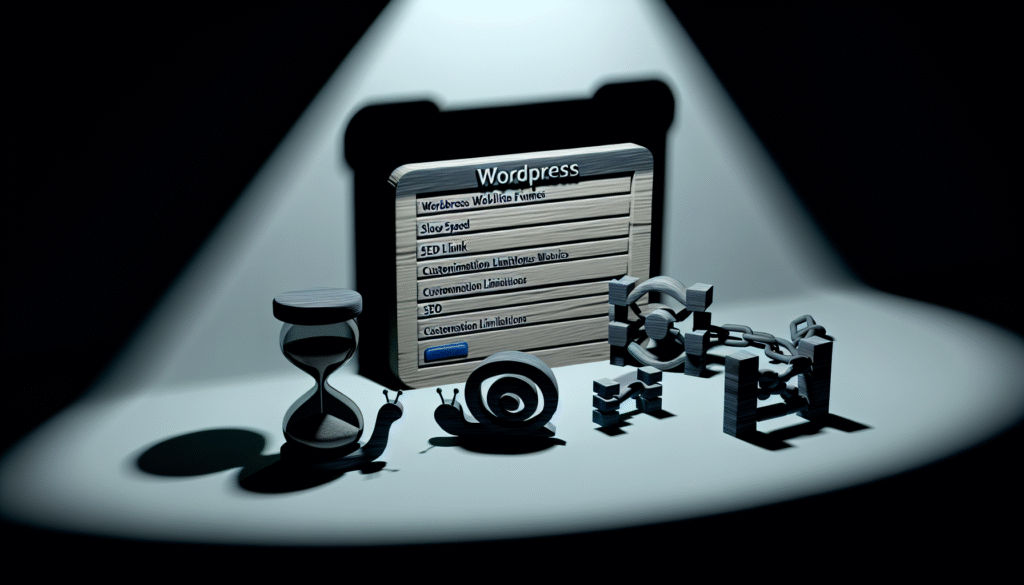The Page Builder Trap: When You Should Say No

WordPress page builders have revolutionized web design for countless users, allowing for easy drag-and-drop site creation without a line of code. However, this seemingly perfect solution harbors a dark side, impacting site performance, customizability, and the user's ability to make intricate customizations. This article delves into the disadvantages and scenarios where WordPress page builders might do more harm than good.
Table of Contents
Performance Pitfalls: How Page Builders Can Slow Down Your Site
When convenience meets performance, there’s often a trade-off. WordPress page builders—like Elementor, WPBakery, and Divi—are loved for their drag-and-drop simplicity. But under the hood, that ease of use can come at a serious performance cost. Bloated code, excessive DOM elements, and redundant scripts are just the beginning of the problem.
Why Speed Matters
Page speed impacts both user experience and SEO. According to Google, 53% of mobile users abandon sites taking longer than three seconds to load. Slower load times also hurt your search engine rankings. Simply put: every extra second costs you traffic and revenue.
The Real Cost of Visual Builders
Behind the shiny UI, many page builders inject your site with:
- Nested divs and unnecessary wrappers that balloon the Document Object Model (DOM), making rendering inefficient.
- Global scripts and styles that load on every page—even if only used in one location.
- Multiple CSS files and inline styles leading to large page sizes and longer time-to-first-byte (TTFB).
For example, a test site built with Elementor loaded over 1MB of extra resources and 100+ HTTP requests—compared to a hand-coded theme loading under 300KB. The difference? Nearly 2.5 seconds in loading time.
How Performance Bottlenecks Hurt Your Business
Slow load times do more than annoy users:
- Increase bounce rates especially from mobile users with limited bandwidth.
- Lower your Page Experience score in Google's Core Web Vitals.
- Reduce conversion rates, particularly on ecommerce and service-based sites.
Mitigation Tactics
If you must use a page builder, optimize aggressively:
- Minify and combine CSS/JS files with plugins like Autoptimize.
- Dequeue unused styles/scripts using helper functions or plugins.
- Lazy-load all media and use a CDN for faster delivery.
For performance-critical sites, consider switching to a lightweight theme with native block support or custom-coded templates.
Key takeaway: Page builders are fast to build with, but slow to load. Choose wisely based on your site's goals.
Curious how your current site stacks up?
Get a free performance audit todayLimitations on Customization: When WordPress Page Builders Restrict Your Creative Vision
For all their convenience, WordPress page builders often fall short when it comes to true design flexibility. The drag-and-drop interfaces and templated elements promise control but subtly impose boundaries. If your site needs a unique visual identity or advanced functionality, you might quickly discover that a page builder is more a cage than a canvas.
Design Freedom—Within Limits
Page builders like Elementor, WPBakery, and Divi make customization accessible—but only within the framework they provide. Their pre-designed modules and style panels cater to popular use cases, not edge-case innovation. If you're trying to implement a non-standard layout, custom animations, or deeply tailored interactions, the builder’s UI often becomes an obstacle rather than a tool.
- Locked-down CSS structure: Builders generate nested HTML and multiple wrapper classes, making targeted styling with custom CSS unnecessarily complicated.
- Limited JavaScript integration: Custom scripts often conflict with how builders handle DOM elements, especially with dynamic content or complex triggers.
- Hook and filter restrictions: While WordPress core supports actions and filters, builders rarely expose them, making functional customization hard without direct theme or plugin edits.
Case Study: Stuck in the Grid
One agency working on a high-end WooCommerce fashion site tried using a popular builder for its fast prototyping. When the client requested an asymmetrical product grid with hover-triggered video previews and micro-interactions, the team hit a wall. The builder’s layout engine simply couldn’t accommodate the design without massive workarounds and bloated inline styles. Eventually, they rebuilt the templates using custom PHP and SCSS—a solution that took longer but performed better and matched the creative brief exactly.
Harder to Scale or Maintain
Even if you bend a builder to your vision, maintaining that setup becomes a nightmare. Tweaks require diving back into convoluted builder interfaces or overwriting inline styles. Adding a multilingual layout, integrating complex APIs, or adapting to new devices often means rebuilding elements from scratch.
Key takeaway: Page builders are fantastic for fast, low-code work—but if your brand demands a standout, customized experience, you're better off going headless or custom theme.
SEO Challenges: How WordPress Page Builders Can Hurt Your Visibility
If you're serious about ranking your WordPress site, page builders might be holding you back more than helping. While they offer design convenience, the trade-off often comes at the cost of search engine optimization. From messy code output to sluggish performance, relying too heavily on a page builder can silently sabotage your SEO efforts.
Bloated Code: When Convenience Becomes a Liability
Page builders typically generate a dense trail of shortcodes, excessive DIVs, and inline styles. The result? Bloated HTML markup that makes it harder for search engine crawlers to understand your content hierarchy. Clean, semantic HTML boosts crawlability and indexation—badly structured page builder code doesn’t.
Take Elementor or WPBakery, for example. A simple content area can output dozens of nested elements that serve no semantic purpose. This not only confuses search engines but also increases your site’s load times.
- Unstructured content confuses search engines trying to understand your page’s purpose
- Heavy DOM trees negatively impact Google’s Core Web Vitals—an important ranking factor
Slow Speeds, Slower Rankings
Page speed is no longer optional. Builders inject unnecessary scripts, styles, and animations that bulk up pages. Even with caching and CDN layers, you’re still starting from a handicap. Google explicitly ties performance to rankings—especially on mobile.
We’ve seen real-world audits where switching from a page builder to a lightweight theme resulted in a 40% decrease in page load time and a noticeable lift in organic traffic within weeks.
- Unused assets: Many builders load JS/CSS sitewide, even if only used on a single page
- Third-party dependencies: Slows down rendering, especially on mobile networks
Rigid Content = Missed SEO Opportunities
Page builders often make it hard to align on-page SEO structure with content strategy. Want to fine-tune heading hierarchy, add structured data, or optimize internal linking? Builders restrict flexibility, either requiring extra plugins or manual overrides.
This hurts dynamic content needs, especially for ecommerce or content-heavy sites. For sites growing with SEO as a backbone, this rigidity is a huge constraint.
Workarounds That Help—but Don’t Fully Solve
Yes, performance plugins and caching layers can patch some issues. But they don’t eliminate the root problems. A better approach?
- Use Gutenberg or a lightweight theme like GeneratePress
- Minimize reliance on builder-specific modules
- Audit your site with tools like WebPageTest or Lighthouse for bloat and crawl errors
A poorly optimized builder-built site won’t scale well—neither for users nor search engines.
Need guidance optimizing your WordPress site for SEO? Contact us for a free technical audit. Get expert clarity on what’s slowing you down.
Long-term Scalability Issues
Long-Term Scalability Issues: Why Page Builders Might Hold Your Site Back in the Future
What feels fast and easy today can become a major headache tomorrow. WordPress page builders streamline the design process—but when it comes to long-term scalability, they often create more problems than they solve. As your business and website grow, what started as a convenient solution can turn into a barrier.
Scaling Your Website Shouldn’t Mean Rebuilding It
Page builders often rely on proprietary code structures that limit flexibility. At first, drag-and-drop layouts seem perfect. But down the road, updating site components—layouts, styling, or even custom functionality—can become painfully slow, especially when you're dealing with layers of nested shortcodes or complex block structures.
Here’s what this bottleneck could look like:
- Stuck with legacy designs: Need to change a global design element? Page builders don’t handle global style changes well. You may need to do it page-by-page.
- Custom functionality challenges: Adding dynamic data, API integrations, or custom post templates? These often require workarounds or custom modules, which increase technical debt.
- Plugin and theme compatibility nightmares: As WordPress core evolves, some page builders lag behind. Incompatibilities with third-party plugins or modern themes can force time-consuming fixes—or worse, full redesigns.
Example: When a Digital Agency Outgrows Its Page Builder
A mid-size digital agency built client sites using a popular page builder. At first, it sped up workflows. But as clients requested more advanced features, like custom dashboards, multilingual support, or headless CMS integrations, the builder’s limitations became clear. The agency ended up refactoring multiple sites—costing time, money, and client trust.
Better Alternatives for Growth-Minded Projects
- Start with a scalable framework: Choose a block-based theme.
- Use Advanced Custom Fields or Gutenberg: These offer more control with less overhead than page builders.
- Modular development: Build reusable components to future-proof the site as functionality evolves.
Planning to grow your WordPress site?
While WordPress page builders offer a convenient entry point for site creation, they are not a one-size-fits-all solution. Considering performance, customization, SEO, and scalability limitations is critical for anyone looking to build a sustainable, efficient website. By acknowledging these drawbacks, one can navigate the complexities of web development with more clarity, choosing tools and approaches that truly benefit their online presence.



